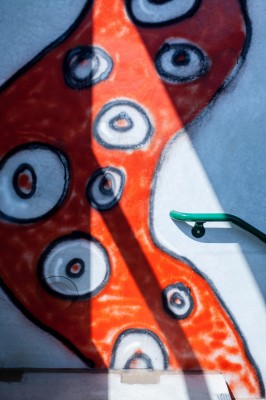Unsolicited artwork around campus costs university thousands in cleanup, removal
Bathroom stalls littered with hate-filled sentiments and other ambiguous graffiti across campus has cost Mason thousands of dollars.
Although students at Mason tend to create art in acceptable campus locations, more obscure forms of graffiti remain on campus. The kind of spray- painted graffiti normally seen in inner cities and on freight trains is not what is normally popping up around campus, though. It is the drawing on bathroom stalls and occurrences of lesser- known graffiti that are costing money.
Recently, some illicit outdoor graffiti has become prominent.
“We get occasional reports [of graffiti],” said Sgt. David Ganley of the Mason Police Department. “We’ll have sprees of things like that.”
In the past year, tags displaying the word “slick” have cropped up around campus. Appearing anywhere from outside of the Patriot Center to the halls of the Robinson buildings, “slick” has become a dreaded adversary to the Fairfax campus.
“As far as that goes, that would be part of an ongoing investigation,” Ganley said. “If people do have information, we encourage them to call our crime solvers tip line here on campus.”
The biggest occurrence of the “slick” tag took place last August on the southern side of the Southside Dining Facility facing the SUBII Building. According to Paint and Sign Shop Supervisor José Vasquez, that tag marked the first time facilities manage- ment knew of “slick.”
“I think it’s over $3,000 on expenses we did to clean up the slick graffiti,” Vasquez said. “‘Slick’ was using all kinds [of paint]. He tried everything to make it difficult for us.”
The “slick” tags have appeared in a variety of mediums — including different colors of spray paint, chalk and permanent marker.
Aside from this type of exterior graffiti, the most abused locations on campus are the bathrooms. Offensive graffiti is often reported, specifically in men’s bathroom stalls in the Johnson Center and Robinson Hall.
“It is definitely an issue,” Vasquez said. “We get a lot of offensive graffiti sometimes like racial graffiti.”
“It is definitely an issue. We get a lot of offensive graffiti sometimes, like racial graffiti.”
Sign Shop Supervisor José Vasquez
Facilities Management has tried to prevent such occurrences by installing a protective coating of graffiti shield on the stalls. Regardless, Director of Facilities Management Larry Spaine says graffiti is definitely increasing the budget.
Another case of graffiti — in a less conventional sense — are the thin, green and gold lines painted on the sidewalks around campus. Although they are found in acceptable sidewalk locations, paint is not allowed.
“That was not anything university sponsored,” said Rose Pascarell, vice president of university life.
Painted in the fall 2011 semester, the perpetrator has yet to be discovered. Whether it’s indoors or outdoors, however, students usually overlook graffiti on campus.
“I’ve heard of it, but I haven’t really seen it,” said Jordan Pohl, a senior at Mason who has lived on or near the Fairfax campus for three years. “It’s not something that stands out to me.”
Aside from the prohibited graffiti on campus, certain kinds of graffiti tagging is allowed. Acceptable locations on campus have been set aside for such activities.

Though permanent graffiti is banned by the university, students are allowed to use chalk to decorate the concrete.(JENNY KRASHIN/BROADSIDE)
“The sidewalks are for anyone to use as long as people chalk them, not paint,” Pascarell said. “If it can be washed off naturally, students can chalk and use them.”
The sidewalks aren’t the only places for students to be creative. The wall between Robinson A and B is available for students to chalk on, as well as the cubes in front of the Southside. These cubes mark the only place on campus where students can use paint with no penalty.
“Part of the goals [of the Office of University Life] is how to make student life and student projects more visible on campus,” Pascarell said.
The Office of University Life installed the cubes a few years ago for student organization advertising.
“One of the reasons we created them was so people could be a little bit more creative,” said Alissa Karton, assistant to the vice president and director of special projects of university life. “That was one way we chose to respond [to graffiti].”
Karton explained that paint carts are offered to student organizations in the Skyline Fitness Center on a first-come, first-serve basis. The cubes are available to paint as long as student organizations are promoting an event seven days in advanced and have a specified date and time.
While graffiti still impacts the Mason’s budget, the Office of University Life and Facilities Management agree that the cubes have helped to reduce such finances.







Comments